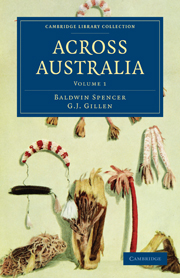CHAPTER IV
Published online by Cambridge University Press: 26 April 2011
Summary
Amongst the most characteristic features of the Lower Steppe-land country are the so-called clay-pans. These are shallow depressions, sometimes surrounded by sand-hills, but very often lying out on the open, plain country. They are not by any means confined to the Lower Steppe lands; in fact, the largest one that we met with–called Conlon's Lagoon–occupied a valley right in amongst the Macdonnell Ranges, and measured a mile in length by half a mile in width (Fig. 25). From this, which is a very extreme size, they vary in extent of area down to only a few square yards. The depth of water that they contain may be only an inch or two, and, at most, two feet. Whatever may be their size they all agree in one feature, which is that they have no outlet. They are formed in such a way that the water draining down into them can only escape by sinking into the ground or by evaporation. There are of course very many depressions in which a clay-pan is not formed, the determining factor being, apparently, the nature of the sediment that the water contains. If this be simply sandy, then it does not hinder the sinking of the water, but if it be of a clayey consistency, then it forms a thin impermeable film which prevents the percolation of the water, and, as a consequence, a clay-pan is formed, in which the muddy water remains until it completely evaporates.
- Type
- Chapter
- Information
- Across Australia , pp. 55 - 73Publisher: Cambridge University PressPrint publication year: 2010First published in: 1912



